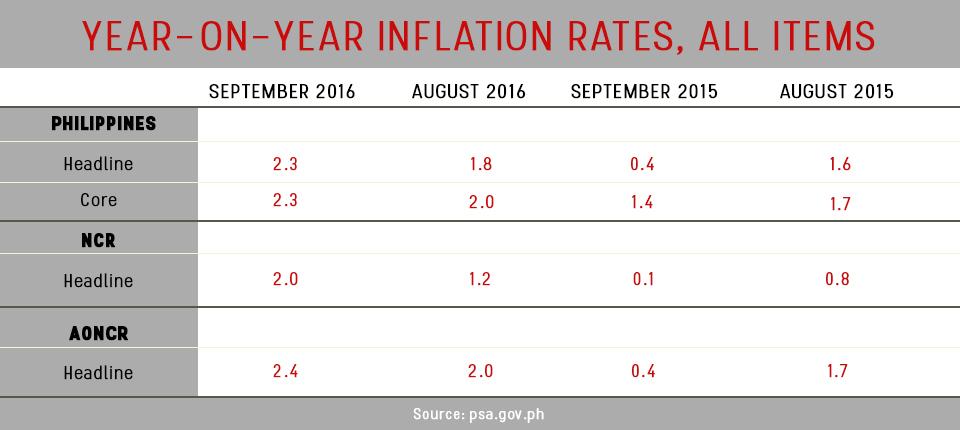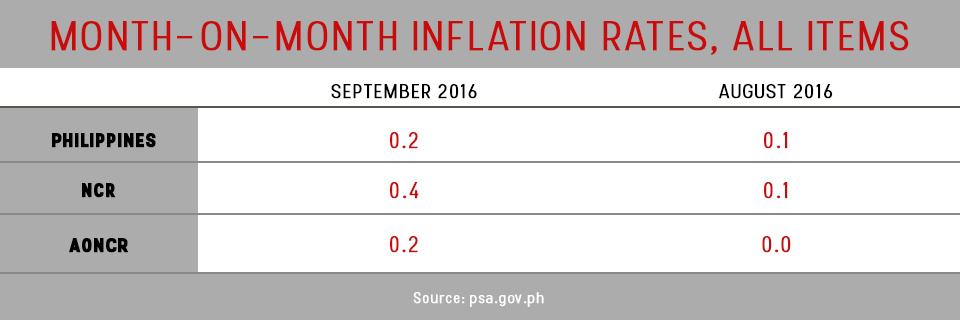Inflation accelerates to 2.3% in September

Philippine inflation accelerated by nearly six-fold in September from a year earlier, the fastest in nearly two years since March 2015, driven by higher prices of both food and non-food items.
Data released on Wednesday by the Philippine Statistics Authority (PSA) showed inflation registered at 2.3 percent last month against 0.4 percent in September 2015.
Commodity prices rose at the fastest pace since clocking in at 2.4 percent in March last year.
"Higher annual increments were noted in the indices of food and non-alcoholic beverages; alcoholic beverages and tobacco; clothing and footwear; housing, water, electricity, gas, and other fuels; furnishing, household equipment and routine maintenance of the house; and transport," the PSA said
The price increases nearly breached the government's inflation target of 1.6 to 2.4 percent.
Last month's inflation rate also accelerated at more than twice the acceleration rate of prices, at 1.8 percent, in August.

Imported rice
Due to the adverse impact of tropical cyclones, food inflation climbed to 3.1 percent in September 2016 from 2.5 percent in August.
However, rice prices are expected to remain steady with additional supply arriving this month, according to the National Economic and Development Authority (NEDA).
"Rice prices will remain stable since the 250,000 MT of rice, imported from Thailand and Vietnam, is expected to arrive by the end of October," NEDA Officer-in-Charge Rosemarie G. Edillon said in a separate email.

'Within forecast'
"Inflation for September at 2.3 percent was within our forecast range and brought the year-to-date average to 1.6 percent," BSP Governor Amando M. Tetangco, Jr. said in a text message to reporters.
"This outturn is consistent with our expectation that inflation will slowly inch up towards the national government target range over the policy horizon," he added.
There is no need to change monetary policy settings for now, Tetangco noted.
"Nevertheless, we will continue to closely monitor developments, including financial market volatility and impact of possible adjustments to the tax structure on consumption patterns and relative prices of how these may be addressed by adjustments in any of our other policy tools." he added.

Surely on the rise
Cid Terosa, dean of the School of Economics at the University of Asia & the Pacific (UA&P), said the latest figures were in line with expectations.
"It was expected for the following reasons: weaker peso, increase in price of rice and cooking fuel, and base effect since last year's inflation rate for the same month was extraordinarily low," he said in a text message.
But with the Chirstmas holidays just around the corner coupled with the volatility in global oil markets, inflation is surely on the rise.
Terosa noted a weaker peso and Christmas-related spending are definitely inflationary. "Also, the volatile conditions related to the price of petroleum may push up prices," he said.
In contrast, the NEDA outlook on prices is quite positive and consumer-friendly.
"Inflation will remain low and stable for the rest of the year with the continuous expansion of the domestic economy, solid private household consumption and investment, buoyant business and consumer sentiment, and adequate credit and domestic liquidity," NEDA's Edillon said. — VDS, GMA News




